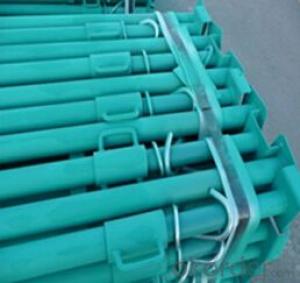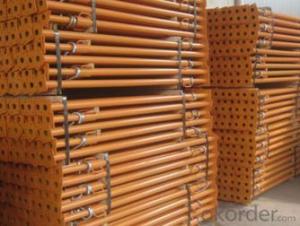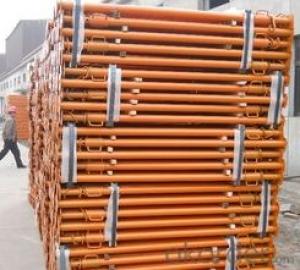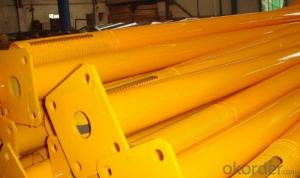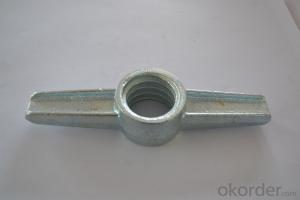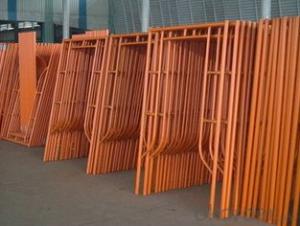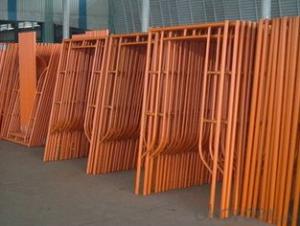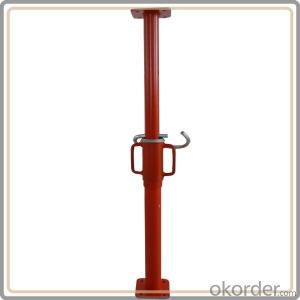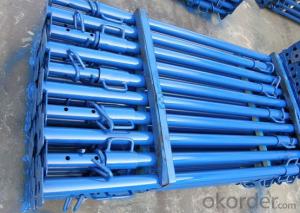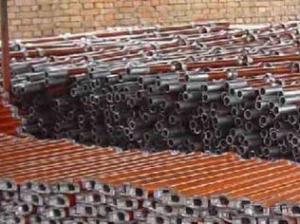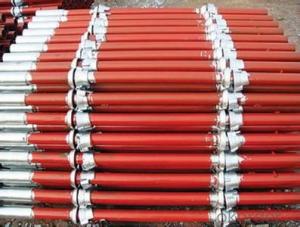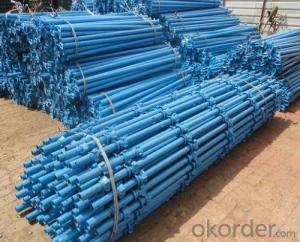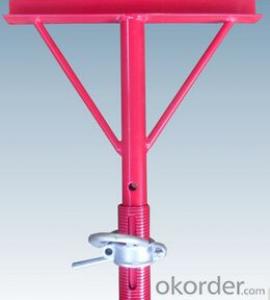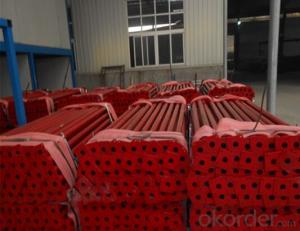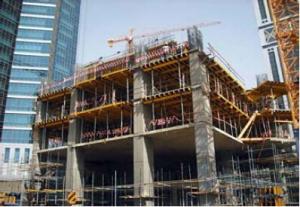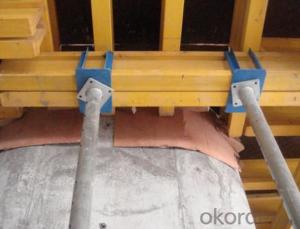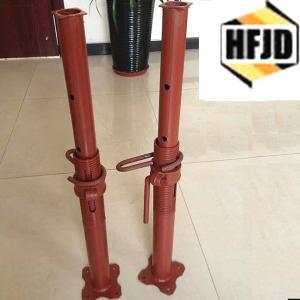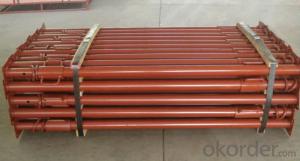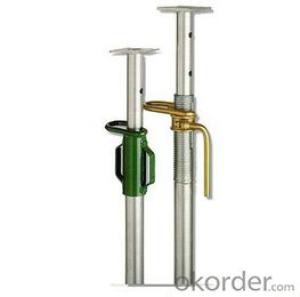CUP TYPE STEEL PROP SCAFFOLDING MANUFACTURERS
- Loading Port:
- Tianjin
- Payment Terms:
- TT OR LC
- Min Order Qty:
- 10000 pc
- Supply Capability:
- 10000 pc/month
OKorder Service Pledge
Quality Product, Order Online Tracking, Timely Delivery
OKorder Financial Service
Credit Rating, Credit Services, Credit Purchasing
You Might Also Like
Quick Details
| Model Number: | MJ scaffolding prop | ||||
| Type: | Scaffolding Parts | Scaffolding Part Type: | Scaffolding Props | material: | Q235 welded pipe |
| types: | heavy duty prop, light duty prop | color: | silver,orange, blue, dark red, etc, as client's request | surface treatment: | galvanized, powder coated, prainted |
| certification: | ISO9001:2008,SGS,BV | application: | civil contruction | components: | prop sleeve, u-head, square plate, cross plate |
| length: | as your request | factory: | yes | pin: | G-lock |
Packaging & Delivery
| Packaging Detail: | 1.packed in bundle, suitable for sea transport. 2.according to client's request |
| Delivery Detail: | within 20 days after we received the deposit or L/C |
Specifications
1.two types: heavy duty prop and light duty prop
2.high strength bear capacity
3.painting powder coating
4.safe and popular
Product Description
| Production Name | Scaffolding prop |
| Material | Q235 steel |
| Type | Light duty prop & Heavy duty prop & Post are available |
| Sizes | as per customer's request |
| Surface treatment | Hot dipped galvanized, Powder coated, Painted |
| Certificate | ISO9001:2008,SGS standard |
| MOQ | A 20ft container |
| Payment | L/C, T/T, 30% in advance |
| Shipment | FOB, CIF, CFR |
| Advantages | High quality,Competitive price,Timely delivery,Safe package,Nice service and OEM service. |
- Q: What is the purpose of a steel prop in construction?
- The purpose of a steel prop in construction is to provide temporary support to structures during various stages of construction or renovation. Steel props, also known as adjustable steel props or steel shore, are typically used to support vertical loads such as beams, slabs, walls, or formwork. These props are adjustable in height, allowing them to be extended or retracted as needed to provide the required support. They are designed to be easy to install, adjust, and dismantle, making them a versatile and cost-effective solution. Steel props are commonly used in construction projects to ensure the stability and safety of structures by preventing excessive deflection or collapse. They help distribute the load evenly and transfer it to a solid foundation, minimizing the risk of structural failure or damage. Furthermore, steel props are often used in conjunction with other construction equipment, such as scaffolding or formwork systems, to create a secure and stable working environment for construction workers. They provide additional support and reinforcement to ensure the integrity of the structure during construction activities. In summary, the purpose of a steel prop in construction is to provide temporary support, enhance structural stability, and ensure the safety of workers and the structure itself.
- Q: Can steel props be used in the installation of temporary fire protection systems?
- Yes, steel props can be used in the installation of temporary fire protection systems.
- Q: Can steel props be used for supporting walls during demolition?
- Yes, steel props can be used for supporting walls during demolition.
- Q: Can steel props be used for supporting formwork beams?
- Yes, steel props can be used for supporting formwork beams. Steel props are commonly used in construction to provide temporary support to various structures, including formwork beams. They are adjustable, versatile, and capable of bearing heavy loads, making them suitable for supporting formwork beams during construction projects.
- Q: Can steel props be used in the installation of heavy machinery?
- Yes, steel props can be used in the installation of heavy machinery. Steel props are sturdy and provide strong support, making them suitable for handling the weight and ensuring stability during the installation process.
- Q: Can steel props be used in mining tunnel construction?
- Yes, steel props can be used in mining tunnel construction. Steel props offer strong support and stability to the tunnel walls, ensuring the safety of the construction process. Additionally, steel props are durable and can withstand the harsh conditions commonly found in mining environments.
- Q: How do you properly set up a steel prop?
- To ensure stability and safety, there are several key steps involved in properly setting up a steel prop. Follow this guide to ensure a proper setup: 1. Evaluate load-bearing requirements: Before setting up the steel prop, it is crucial to assess the weight and load it will bear. This evaluation will help determine the appropriate prop size and capacity needed for the job. 2. Select the appropriate prop: Choose a steel prop that meets the load-bearing requirements determined in step one. Consider factors such as prop height adjustment range, weight capacity, and overall durability. 3. Prepare the area: Clear the designated area of any debris, obstacles, or loose materials that could compromise stability. Ensure the ground is level and solid to provide a sturdy foundation. 4. Adjust the prop's height: Extend the steel prop to the desired height by turning the adjustment collar. Make sure the collar is securely tightened to avoid accidental retraction during use. 5. Place the prop correctly: Position the steel prop at the desired location, ensuring it is perpendicular to the ground and aligned with the load-bearing point. Use a spirit level, if necessary, to check for vertical alignment. 6. Secure the prop: Once the prop is correctly positioned, secure it in place. This can be done by using adjustable steel plates or timber needles to provide additional support and prevent movement. 7. Check for stability: Gently apply pressure to the prop to inspect its stability and ensure it can bear the anticipated load. If any instability is detected, adjust the prop's height or reposition it until it is secure. 8. Regularly monitor and maintain: Throughout the project, it is crucial to regularly monitor the prop's stability. Inspect for signs of wear, damage, or shifting, and address any issues immediately. Additionally, avoid exceeding the prop's recommended capacity. Remember, proper setup of a steel prop is essential for project success and the safety of workers and the surrounding environment. Always follow manufacturer guidelines and local regulations when working with steel props to ensure a secure and stable setup.
- Q: Are steel props adjustable at 45-degree angles?
- No, steel props are not adjustable at 45-degree angles. Steel props, also known as steel acrow props or steel shoring props, are vertical supports used in construction to provide temporary support to structures or formwork. They are typically adjustable in height, allowing for easy customization to fit various construction needs. However, the adjustment mechanism usually allows for vertical adjustment only, and not for adjustment at specific angles such as 45 degrees. If a 45-degree angle is required, alternative methods or supports would need to be used.
- Q: Are steel props commonly used in bridge construction projects?
- Steel props, which are vertical columns made of steel, are frequently employed in bridge construction projects. These temporary supports, also referred to as steel props, are utilized to provide temporary support to structures such as bridges throughout the construction process. Their purpose is to bear the weight of the bridge deck and other construction materials until the completion of the bridge, when it can independently support itself. The preference for steel props in bridge construction projects arises from their strength, durability, and capacity to withstand heavy loads. Additionally, their adjustability and ease of installation and removal make them a cost-effective and efficient option for temporary support in bridge construction.
- Q: How do you prevent overloading of steel props?
- To prevent overloading of steel props, it is essential to follow a few key measures. Firstly, it is crucial to accurately determine the load-bearing capacity of the steel props and ensure they are not exceeded. This can be achieved by consulting structural engineering guidelines or seeking professional advice. Additionally, regular inspections and maintenance of the props are necessary to identify any signs of wear, damage, or deformation that may compromise their strength. Adequate bracing and support should also be employed to distribute the load evenly and prevent excessive pressure on individual props. Lastly, it is important to educate and train workers on the proper use and limitations of steel props to minimize the risk of overloading.
Send your message to us
CUP TYPE STEEL PROP SCAFFOLDING MANUFACTURERS
- Loading Port:
- Tianjin
- Payment Terms:
- TT OR LC
- Min Order Qty:
- 10000 pc
- Supply Capability:
- 10000 pc/month
OKorder Service Pledge
Quality Product, Order Online Tracking, Timely Delivery
OKorder Financial Service
Credit Rating, Credit Services, Credit Purchasing
Similar products
Hot products
Hot Searches
Related keywords
